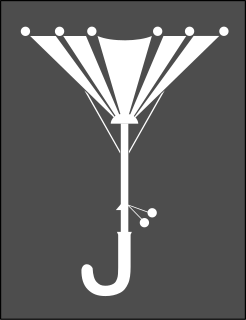
The 54th Infantry Division was an infantry division of the British Army. The division was raised in 1908 following the creation of the Territorial Force (TF) as the East Anglian Division. During the First World War the division fought at Gallipoli and in the Middle East. The division was disbanded after the war but reformed in the Territorial Army in 1920. During the Second World War it was a home service division and did not see any combat service abroad and was disbanded in late 1943 but many of its component units went to see service in the Normandy Campaign and North-western Europe from June 1944 to May 1945.
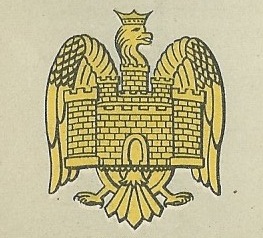
The Bedfordshire Yeomanry was a Yeomanry regiment of the British Army. Serving intermittently between 1797 and 1827, it was re-raised in 1901 for the Second Boer War. It participated in the First World War before being converted to an artillery regiment. It served in the Second World War. Its lineage was maintained by 201 Battery, 100th (Yeomanry) Regiment Royal Artillery until that unit was placed in suspended animation in 2014.

The Norfolk Yeomanry was a volunteer cavalry (Yeomanry) regiment of Britain's Territorial Army accepted onto the establishment of the British Army in 1794. After seeing action in the Second Boer War, it served dismounted at Gallipoli, in Palestine and on the Western Front during the First World War. Between the wars it converted to the Royal Artillery (TA), and served as an anti-tank regiment in France, the Western Desert, Italy and North West Europe during the Second World War. After the war it served as a TA air defence unit and then as an Army Air Corps unit.
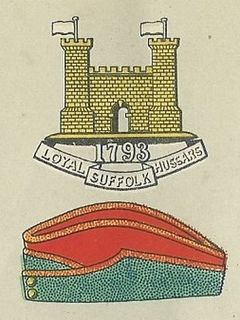
The Duke of Yorks Own Loyal Suffolk Hussars was a Yeomanry regiment of the British Army. Originally formed as a volunteer cavalry force in 1793, it fought in the Second Boer war as part of the Imperial Yeomanry. In the World War I the regiment fought at Gallipoli, in Palestine and on the Western Front. The unit was subsequently converted into a Royal Artillery unit, serving in the anti-tank role North Africa, Italy and France during World War II. The lineage is maintained by No. 677 Squadron AAC.

The Royal Buckinghamshire Yeomanry is an Operational Hygiene Squadron of the Royal Logistic Corps, originally formed as cavalry in 1794, and has also served in artillery and signals roles. The lineage is continued by 710 Operational Hygiene Squadron, Royal Logistic Corps.
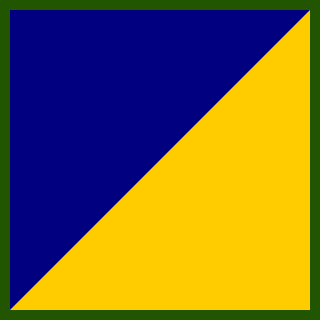
The Pembroke Yeomanry was a regiment of the British Army formed in 1794. It saw action in the Second Boer War, the First World War and the Second World War. The lineage is maintained by 224 Transport Squadron, part of 157 (Welsh) Regiment RLC.

The Hertfordshire Yeomanry was a Yeomanry Cavalry regiment of the British Army that could trace its formation to the late 18th century. First seeing mounted service in the Second Boer War and World War I, it subsequently converted to artillery. Three regiments saw service in World War II, one of which was captured at the fall of Singapore. It continued through various postwar amalgamations and its lineage was maintained by 201 Battery, 100th (Yeomanry) Regiment Royal Artillery until that unit was placed in suspended animation in 2014.

The East Midland Brigade was an infantry brigade of the Territorial Force, part of the British Army, that was raised in 1908. As the name suggests, it commanded infantry battalions recruited in the East Midlands of England: Bedfordshire, Northamptonshire, Cambridgeshire and Hertfordshire. The brigade was an integral part of the East Anglian Division.
The West Riding Royal Horse Artillery was a Territorial Force Royal Horse Artillery battery that was formed in the West Riding of Yorkshire in 1908. It saw active service as field artillery with 52nd (Lowland) Division in Egypt during the First World War before being broken up at the end of 1916. Post-war, it was reconstituted as a Royal Field Artillery battery.
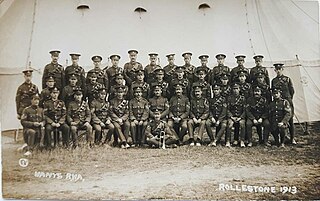
The Hampshire Royal Horse Artillery was a Territorial Force Royal Horse Artillery battery that was formed in Hampshire in 1909. It saw active service during the First World War in Egypt and Palestine from 1916 to 1918, initially as field artillery with 52nd (Lowland) Division before being converted back to horse artillery and serving with the Yeomanry Mounted Division and 1st Mounted / 4th Cavalry Division. A second line battery, 2/1st Hampshire RHA, served on the Western Front in 1917 and 1918 as part of an Army Field Artillery Brigade. Post-war, it was reconstituted as a Royal Field Artillery battery.
The Essex Royal Horse Artillery was a Territorial Force Royal Horse Artillery battery that was formed in Essex in 1908. It saw active service during the First World War in Egypt and Palestine from 1916 to 1918, initially as field artillery with 52nd (Lowland) Division before being converted back to horse artillery and serving with the 2nd Mounted / 5th Cavalry Division. A second line battery, 2/1st Essex RHA, served on the Western Front in 1917 and 1918 as part of an Army Field Artillery Brigade.
The Glamorganshire Royal Horse Artillery was a Territorial Force Royal Horse Artillery battery that was formed in Glamorganshire in 1908. It saw active service during the First World War on the Western Front in 1917 and 1918 as part of an Army Field Artillery Brigade. A second line battery, 2/1st Glamorganshire RHA, served in England and Ireland before being broken up in January 1917. Glamorganshire RHA was not reconstituted in the post-war Territorial Force.
The Somerset Royal Horse Artillery was a Territorial Force Royal Horse Artillery battery that was formed in Somerset in 1908. It saw active service during the First World War in the Sinai and Palestine Campaign with the ANZAC Mounted Division from 1916 to 1918. A second line battery, 2/1st Somerset RHA, served on the Western Front with the 63rd Division from 1916 to 1918. It was disembodied after the end of the war and was not reconstituted in the Territorial Force in 1920.

The Leicestershire Royal Horse Artillery was a Territorial Force Royal Horse Artillery battery that was formed in Leicestershire in 1908. It saw active service during the First World War in Egypt and Palestine from 1916 to 1918, initially with ANZAC Mounted Division before joining the Yeomanry Mounted Division and 1st Mounted / 4th Cavalry Division. A second line battery, 2/1st Leicestershire RHA, served on the Western Front with the 63rd Division from 1916 to 1918. Post-war, it was reconstituted as a Royal Field Artillery battery.
The Shropshire Royal Horse Artillery was a Territorial Force Royal Horse Artillery battery that was formed in Shropshire in 1908 from the Shropshire Battery of the 1st Shropshire and Staffordshire Artillery Volunteers, Royal Garrison Artillery of the Volunteer Force. It saw active service during the First World War on the Western Front in 1917 and 1918 as part of an Army Field Artillery Brigade. A second line battery, 2/1st Shropshire RHA, also served on the Western Front in 1917 and 1918 as part of another Army Field Artillery Brigade. It was reconstituted post-war as a medium artillery battery and served as such in the Second World War.
The Northamptonshire Battery, Royal Field Artillery was a unit of Britain's Territorial Force from 1908 to 1919. It served in the Sinai and Palestine Campaign during World War I. In World War II the battery fought in the Malayan Campaign and was captured at the Fall of Singapore.

The 1st Essex Artillery Volunteers was a unit of Britain's part-time auxiliary forces raised in Essex in 1860 in response to an invasion scare. It served under various designations as field artillery in Palestine during World War I. During World War II its units served as mountain artillery in Italy and as jungle artillery and medium artillery in Burma. Postwar it became an airborne unit until it was merged with other units in the 1950s.

The 1st Norfolk Artillery Volunteers was a unit of Britain's Volunteer Force raised in the County of Norfolk in 1859 as a response to a French invasion threat. It became part of the Territorial Force in 1908 and served under various designations as field artillery in Palestine during World War I, and as heavy anti-aircraft artillery in North Africa and Italy during World War II. It disappeared in a merger in 1955.
The 1st Suffolk Artillery Volunteers was a unit of Britain's Volunteer Force and Territorial Army from 1860 until 1955. Raised at Lowestoft in Suffolk, it served under various designations, as field artillery in Palestine during World War I and as heavy anti-aircraft artillery defending the UK during World War II.
The Cumberland Artillery was a group of Volunteer artillery batteries formed in the county of Cumberland, England, in 1860. They became part of the Royal Garrison Artillery, and when the Territorial Force was created in 1908 they formed a Royal Field Artillery howitzer brigade for the East Lancashire Division. In World War I the brigade served at Gallipoli and in Egypt, then was broken up amongst the divisional artillery: its batteries fought on the Western Front for the rest of the war. In the 1920s the Cumberland Artillery batteries combined with the Westmorland and Cumberland Yeomanry to form a new field regiment of the Royal Artillery that saw considerable action in World War II.











